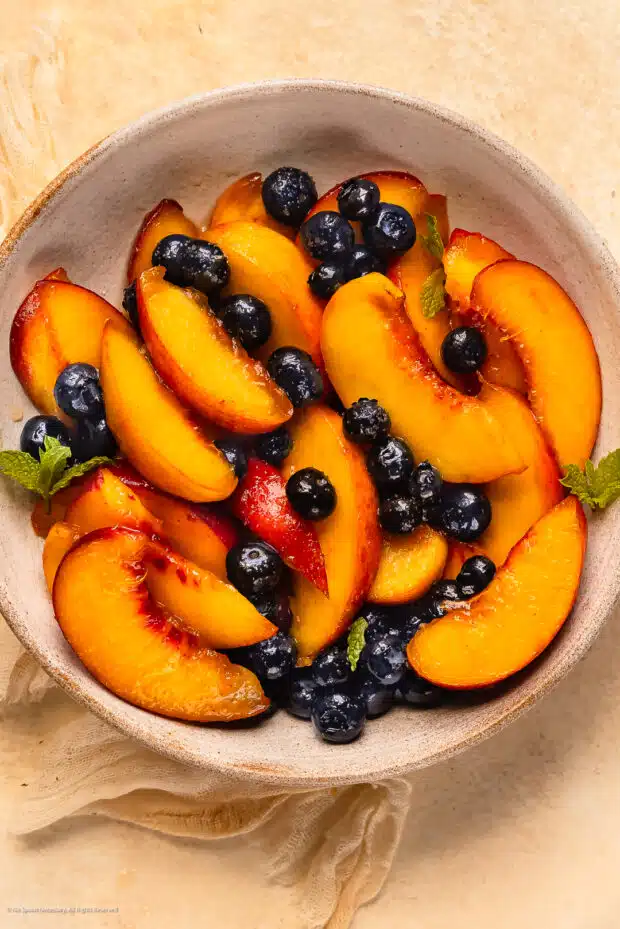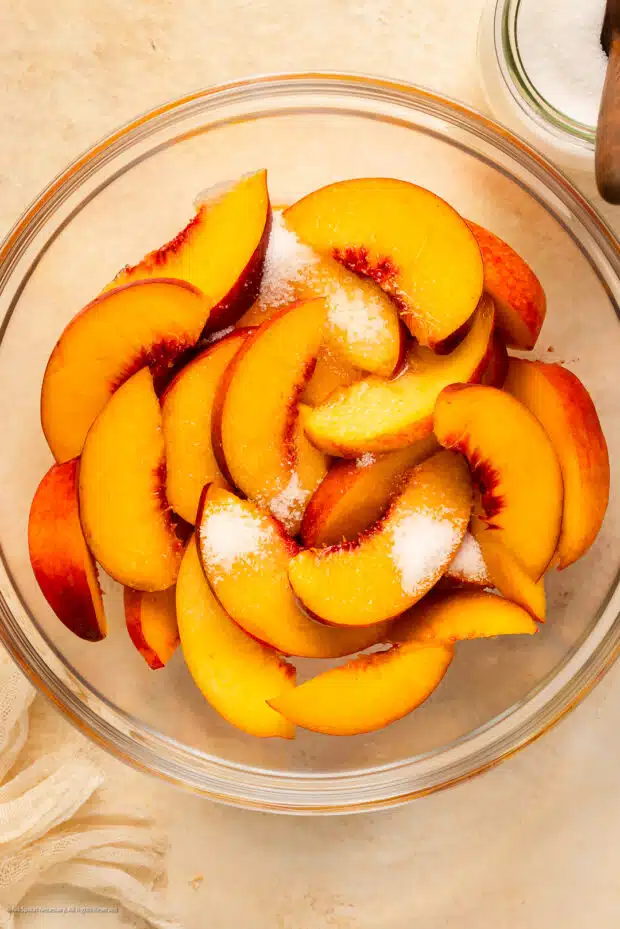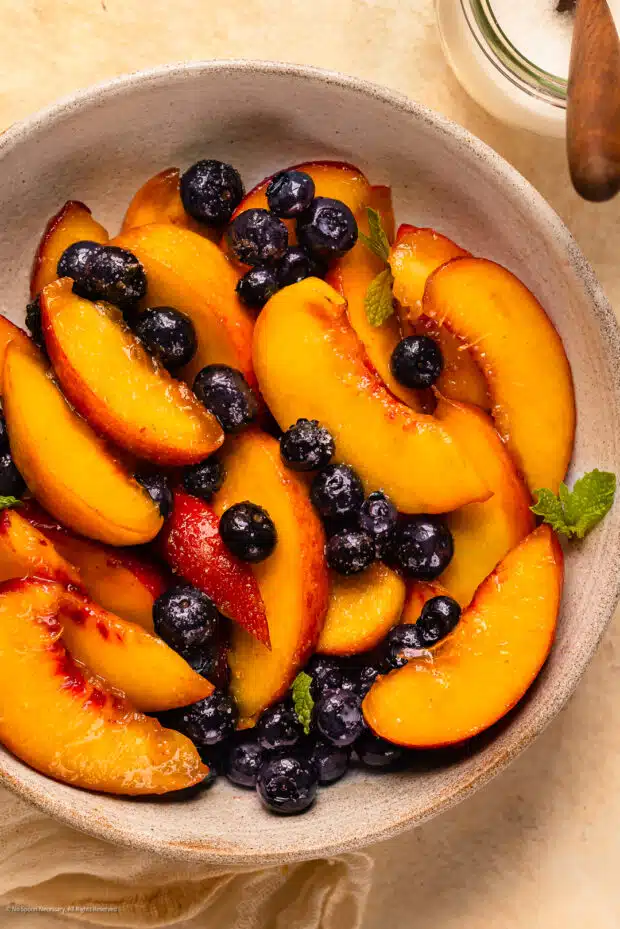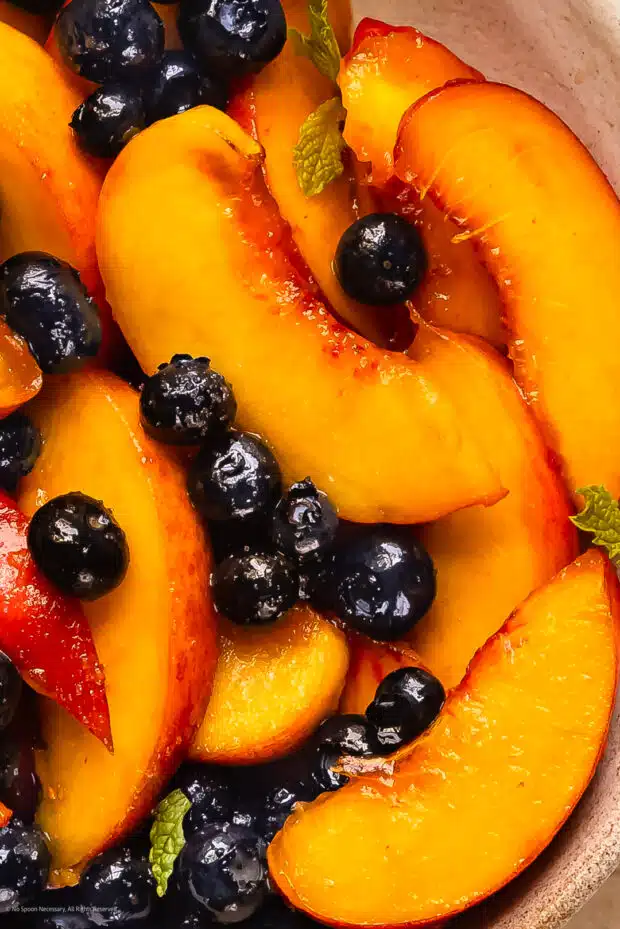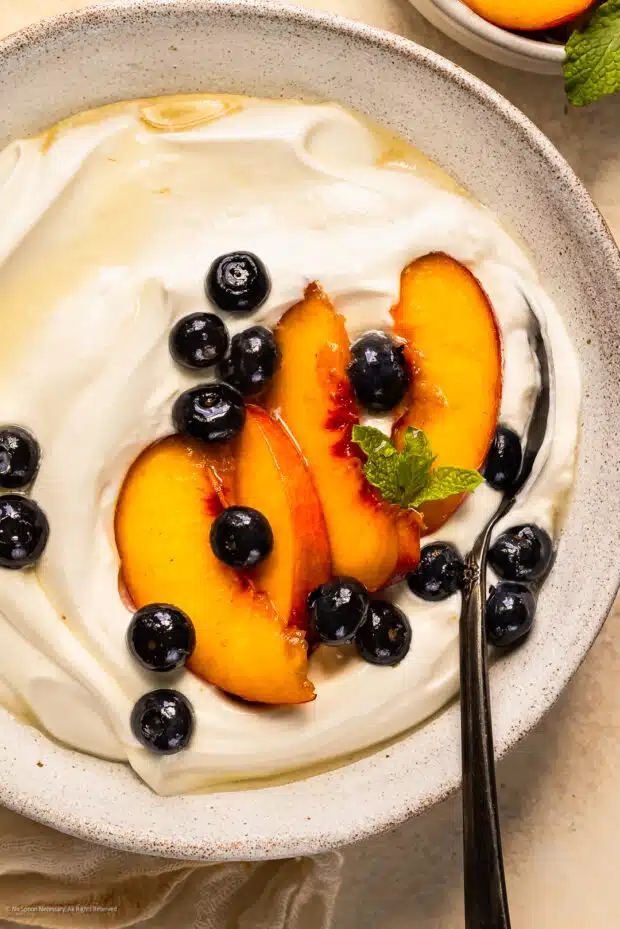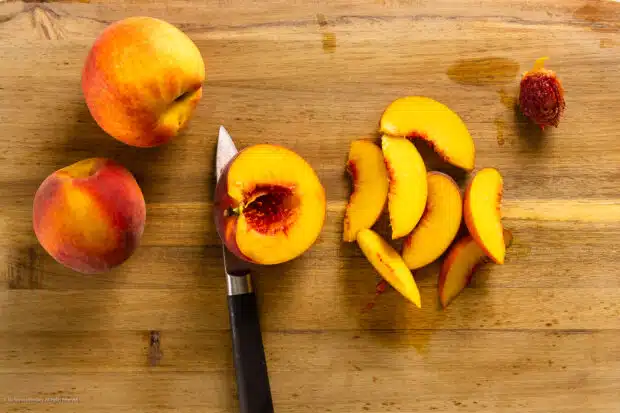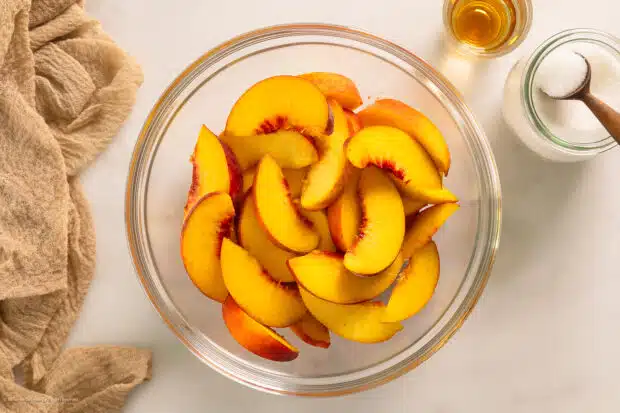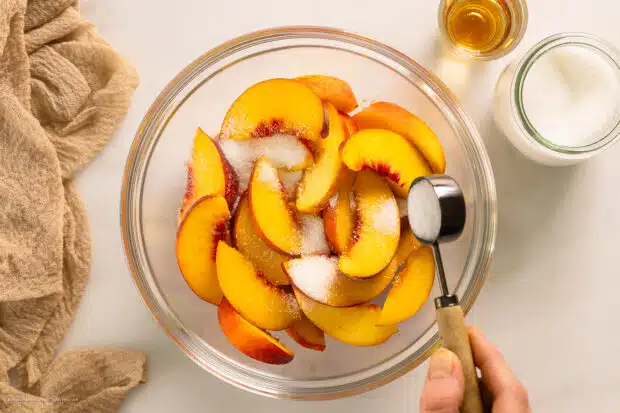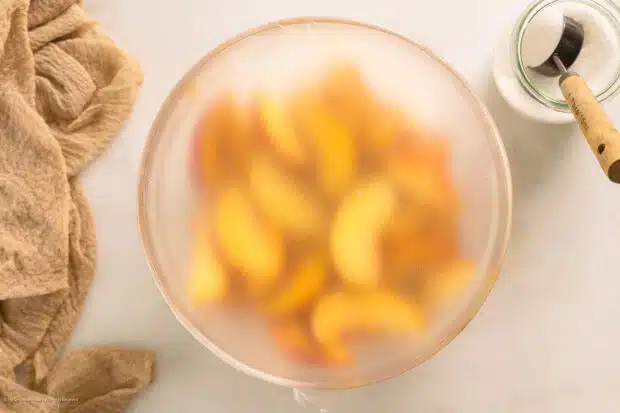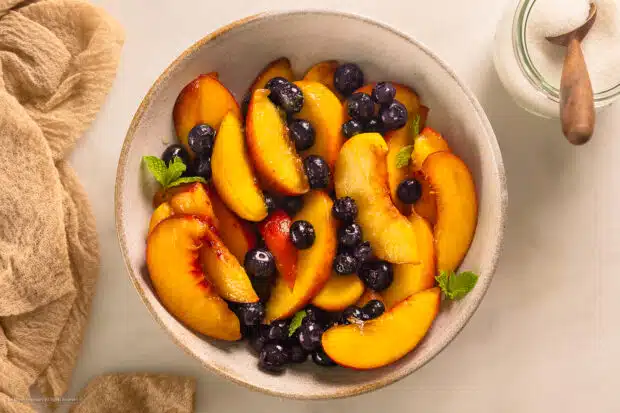This post may include affiliate links. Thank you for your support.
Indulge in a burst of fruity bliss that’s just two ingredients away! With a mere 10 minutes of your time and a dash of sweetness, you can unlock the secret of how to soften fruit and make it sweeter – macerating. Welcome to my tutorial on How To Macerate Fruit – a simple technique that elevates breakfasts and desserts to a whole new level of yum!
Table of Contents
- Why you’ll love macerating
- Maceration definition
- Why should I macerate fruit?
- How long does macerating fruit take?
- Ingredients for macerated fruit
- How To macerate fresh fruit
- How to macerate dried fruit
- FAQs: fruit maceration
- Serving macerated fruits
- Storing macerated fruits
- Recipes with macerated fruits!
- Macerating Fruit Recipe
Why you’ll love macerating
It’s endlessly adaptable. Embrace the adventurous foodie within you, as maceration welcomes nearly any fruit you have on hand. Summer’s juicy peaches, winter’s tangy citrus, autumn’s apples, and spring’s strawberries – all have a ticket to the macerated fruit party. Even dried fruits can partake in this tantalizing transformation, lending their chewy, concentrated goodness to the mix.
It’s so stinkin’ easy! The magic of maceration lies in its simplicity. Just grab the fruit of your choice and sprinkle it with a pinch of sugar. That’s it! The sugar merely coaxes out the innate sweetness of your fruit, enhancing the natural flavors without overpowering them. Marinating fruit also softens it, making it easy to incorporate into tons of applications without needing to cook it first.
It’s the gateway to FlavorTown. Once your fruit has been kissed by sugar and left to macerate, it’s ready to play the starring role in a variety of culinary performances. Breakfast will never be the same again when you crown your pancakes and waffles with a generous spoonful of macerated berries.
Or, imagine a luscious whipped yogurt bowl, adorned with a colorful medley of macerated mango and kiwi – each spoonful like a colorful party popper for your mouth. And for dessert lovers, create delectable ice cream sundaes with a medley of sugar marinated fruits, topped with whipped cream and crowned with a sprinkle of nuts.
Maceration definition
What’s the meaning of maceration? And what does “macerated” mean? In a nutshell, it is the secret to turning your everyday fruit into something extraordinary. Don’t worry; it’s not as complicated as it sounds!
Maceration is a fancy culinary term that simply means transforming fresh or dried fruits into soft, ultra-flavorful, and juicy goodness. All you need is your favorite fruit and a sprinkle of sugar, and you’re on your way!
When you macerate fruit with sugar, you’re basically giving it a relaxing spa treatment – a chance for it to soften up and soak in all the sweet love.
During this cozy sugar bath, something magical happens – the sugar draws out the natural juices from the fruit, infusing it with sweetness and intensifying its flavors. It transforms ordinary fruit into the VIPs of your meals, from breakfast delights like pancakes and waffles to dreamy dessert sundaes.
And the best part? You can use nearly any fruit you have on hand. So, if you have a bunch of ripe berries or some leftover dried fruits hiding in your kitchen, they’re just begging to be macerated!
How to pronounce macerate
It’s a lot like it looks — “mah-SIR-ate.”
Why should I macerate fruit?
Let me give you some juicy reasons! First and foremost, macerating fruit is like giving it a ticket to flavor paradise. When you let the fruit soak in a bit of sugar, it draws out all those natural juices, making it softer, sweeter, and bursting with flavor.
Plus, it’s super simple and doesn’t require any complicated techniques or fancy equipment. With just 10 minutes and two ingredients – your favorite fruit and some sugar – you can work some mealtime magic. It’s the perfect hack for busy foodies who want a quick and delightful upgrade to their favorite breakfast or dessert dishes.
Another fantastic reason to macerate fruit is its versatility. You can go wild with your choice of fruit! Whether it’s the lusciousness of summer berries, the succulence of stone fruits, or the zing of citrus, they all play well with maceration. You can even use dried fruits, so don’t let anything go to waste in your pantry.
Aside from sweet eats, macerated fruit also makes for a fantastic topping in cocktails or mocktails, adding a burst of fruity goodness to your drinks. So if you like to get creative with beverages, this technique is your new best friend.
And the best part? Macerated fruit is a gift that keeps on giving. You can make a big batch and store it in the fridge for a few days. It just keeps getting better as the flavors meld together over time.
How long does macerating fruit take?
There are no hard and fast rules here – you do you! It’s all about finding what tickles your taste buds and fits your busy schedule just right.
Grab your favorite fruit, sprinkle some sugar, and let the magic begin! In just about 10 minutes, you’ll see and taste the incredible transformation. The sugar works its charm, coaxing out those natural fruit juices and turning your fruit into a flavor sensation.
If you want to take it to the next level, give your fruit a little more time to macerate — around 20-30 minutes will do the trick. This extra love bath makes the flavors go deep and the fruit even juicier and softer. Yum!
It’s also important to remember that different fruits have their own tempo. Harder fruits like apples may need a bit more patience to get perfectly macerated, while delicate berries can work their magic in no time.
If you’re feeling extra patient, you can macerate your fruit overnight. Oh, the anticipation! Trust me, it’s worth it. The flavors get all intense, and the texture becomes pure bliss. Perfect for a breakfast or dessert treat that’ll make everyone go “Wow!”
Ingredients for macerated fruit
As promised, you only need 2 simple ingredients to jump into the world of macerated fruit recipes. Here’s what to grab:
- Fresh Fruit – You can use this recipe to macerate most of your favorite fruits – berries, apples, mangoes, peaches, cherries, oranges, kiwis, and the list goes on. You can even use dried fruit, too!
- Granulated Sugar – This is the most neutral-flavored sweetener out there, which means your macerated fruit will taste like a slightly sweeter version of itself.
- Feel free to swap in the sweetener of your choice including brown sugar, maple syrup, or honey.
Optional variations
The best thing about fruit maceration is you can go totally buck wild with your flavor ideas! Here are just a few fun add-ins to get your creative juices flowing:
- Fresh Citrus – Either fresh citrus juice, zest, and/or peel
- Fresh Herbs – e.g. basil, mint, Thai basil, tarragon, or thyme
- Flavor Extracts – e.g. vanilla, almond, hazelnut, or maple
- Liquor or Liqueurs – e.g. vodka, rum, bourbon, triple sec, amaretto, or Frangelico
- Vinegar – e.g. balsamic, white balsamic, champagne, apple cider, or sherry vinegar
- Spices, Seasonings, and Such – e.g. ginger, cinnamon, chili powders
Did you come up with something extra delicious to add to your soaked fruit? Let me know in the comments below so I can give it a whirl!
How To macerate fresh fruit
Macerating your favorite fresh fruits is an incredibly easy process. Here’s what you’ll do:
- Hull, Peel, Chop, or Slice Fresh Fruit (as needed): Hull strawberries, peel kiwis, and chop or slice any larger fruits, such as peaches.
- Add Fresh Fruit to Bowl: Transfer all the fruit to a large non-reactive bowl.
- Sprinkle on Sugar: Sprinkle the sugar, along with any flavor enhancers, evenly over the fruit in the bowl. Then use a wooden spoon or rubber spatula to gently stir, evenly coating the fruit in the sugar.
- Macerate: Cover the bowl with a lid or plastic wrap. Set aside and let the fruit soak in the sugar for 20-30 minutes, or until a syrup forms and the fruit softens. (Note: While not required, I like to stir the fruit halfway through the maceration time for even fruit-liquid-absorption.)
- Use or Store in Fridge: Enjoy the macerated berries or soaked fruit over whipped yogurt, ice cream, pancakes, waffles, and more; or enjoy plain, straight from the bowl. Alternatively, you can transfer the covered bowl of macerated fruit to the refrigerator and store it for up to 6 hours. (Note: The longer the fruit sits, the softer and more flavorful it will become; however, after a lengthy storage, it will turn mushy!)
How to macerate dried fruit
Want to try your hand at macerating dry fruit instead of fresh? No worries – I got you! Please note you will need a liquid such as water, alcohol, or liqueur to rehydrate the dried fruit. Here’s what you’ll do:
- Add Dry Fruit to Bowl: Add 1 cup of dry fruit to a large non-reactive bowl.
- Add Sugar and Liquid: Sprinkle 2 tablespoons of sugar evenly over the fruit. Then pour 3/4 cup of liquid over the dry fruit.
- Macerate Dried Fruit: Give everything a good stir and then cover the bowl with plastic wrap. Let the dried fruit stand for at least 2 hours. (Note: While not required, I like to stir the dry fruit halfway through the maceration time for even rehydration.)
- Use or Store in Fridge: Enjoy the macerated berries or soaked fruit over whipped yogurt, ice cream, pancakes, waffles, and more; or enjoy plain, straight from the bowl. Alternatively, you can transfer the covered bowl of macerated fruit to the refrigerator and store it for up to 6 hours.
Expert tips for the maceration process
Here are some expert tips to take your macerating game to the next level:
- Start with a Clean Slate: Be sure to clean the fresh fruit with cool water and thoroughly pat it dry before macerating.
- Consider the Fruit Size: Before sugaring fruits, cut them into bite-sized pieces to help them absorb the sugar more effectively and create a uniform texture.
- Control the Sweetness: Taste the fruit before adding sugar to assess its natural sweetness. This way, you can adjust the amount of sugar to avoid overpowering the fruit’s inherent flavors.
- Macerate Overnight for Intense Flavors: If you have the time, consider macerating the fruit overnight in the refrigerator. This allows the flavors to meld together and intensifies the taste.
- Keep an Eye on Softer Fruits: Softer fruits like berries and stone fruits will macerate faster, so don’t leave them too long or they might turn mushy.
- Use a Glass or Non-Reactive Bowl: When macerating fruit, use a glass or non-reactive bowl. Avoid metal bowls, as they can interact with the fruit acids and alter the taste.
- Be Mindful of Dried Fruits: If you’re using dried fruits, they will require more time to soften and absorb the flavors. Consider soaking them in warm water, liquor, or fruit juice before macerating.
- Experiment with Liquors: Don’t be afraid to experiment with different types of liquors like brandy, rum, or liqueurs. Soaking fruit in these potent libations adds unique flavors and depth.
- Save the Juices: Once the fruit is macerated, don’t waste the flavorful juices. They make a fantastic syrup that you can drizzle over the fruit or use as a mixer for beverages.
FAQs: fruit maceration
Do you need sugar to macerate fruit?
The short answer is: no, you don’t have to use sugar for fruit maceration if you prefer not to. Hooray!
Instead of sugar, honey, splenda, or stevia are all fantastic alternatives that can add sweetness to your macerated berries or any other fruit you want to try. The key is finding what suits your preferences best.
Honey brings a lovely natural sweetness and a hint of floral flavor to the mix. Splenda and stevia are great options if you’re looking for low-calorie or sugar-free alternatives.
The process remains the same – let your berries hang out with the sweetener of your choice, and the magic will still happen. The sweetener will draw out the fruit juices, making your berries soft, juicy, and delicious.
Are frozen fruits pre-washed before freezing?
Yep! The great thing about frozen fruit is it’s already prepped and ready to use — all you need to do is open the bag!
Does fruit absorb alcohol?
Sure does! Fruit indeed absorbs alcohol as it soaks, and it’s a fantastic way to infuse them with unique flavors and create deliciously boozy treats.
Softer fruits like berries or peaches can absorb alcohol relatively quickly, usually within 30 minutes to an hour. They’ll become infused with the alcohol and take on the flavors beautifully.
For firmer fruits like apples or pears, it may take a bit longer to get that full absorption and flavor infusion — usually a few hours to overnight.
If you want to achieve a more intense and concentrated flavor, you can soak the fruit in alcohol for an extended period. Some recipes even call for soaking fruit for several days to create a potent and flavorful concoction.
The longer you soak fruit in alcohol, the more alcohol it will absorb, and the stronger the final result will be. Always taste and check the booze-soaked fruit as you go along to ensure it reaches your desired level of infusion. And remember, enjoy your boozy fruit creations responsibly!
How long does maceration last?
Generally speaking macerated fruit is best enjoyed within a few hours to a few of days. After that, it’s likely the fruit will start to ferment.
For softer fruits like berries, peaches, or plums, maceration typically takes anywhere from 10 minutes to a few hours. Harder fruits like apples or pears might require a longer maceration time, often ranging from a few hours to overnight. This allows the fruit to fully absorb the sweetness and flavors from the macerating mixture.
It’s important to keep in mind that the macerated fruit will continue to soften and change in flavor over time. Just don’t wait too long to indulge in its juicy goodness!
Can you macerate fruit overnight?
Yup! When you macerate fruit overnight, the sugar or sweetener draws out the natural juices and creates a beautiful syrupy consistency. This process enhances the fruit’s taste and texture, making it soft, juicy, and utterly irresistible.
So, if you have the time and patience, go ahead and let your fruit macerate in the refrigerator overnight. This works especially well for firmer fruits like apples or pears, as the extended soaking time allows them to absorb the flavors fully.
Serving macerated fruits
There’s no shortage of ideas for putting your sugar fruit maceration to work. Here are some mouthwatering serving suggestions to get you started:
- Balsamic Basil Strawberry Bliss: Macerate strawberries with a drizzle of balsamic vinegar, a sprinkle of fresh basil, and a zesty squeeze of lemon. This delightful combo adds a burst of tangy, herby goodness to your strawberries, making them perfect for topping blueberry ice cream, whipped yogurt, or enjoying on their own.
- Rum-tastic Fruit Fiesta: Mix up a variety of fruits and drench them in dark rum for a tropical twist. Sprinkle some fresh mint and a pinch of flakey sea salt for that extra oomph. This rum macerated salad is an irresistible treat for summer gatherings and BBQs.
- Berries with a Brandy Punch: Gather a medley of juicy berries and let them soak up the rich flavors of brandy. The brandy-soaked berries are delightful over vanilla ice cream or layered in a trifle with whipped yogurt.
- Peaches with a Boozy Twist: Macerate peaches with a delightful mix of brown sugar, amaretto, and a splash of pure vanilla extract. You’ll be amazed at how the flavors marry together to create a caramelized, fruity heaven. Top your peach pudding, cinnamon toast, pancakes, or cinnamon waffles with these deliciously boozy peaches for a breakfast upgrade. Or serve your juicy peaches with a microwave coffee mug cake for an easy, yet unforgettable breakfast.
- Blood Orange Blueberry Zing: Revamp your blueberries with a hint of sophistication! Swap the white sugar for agave. And, zest some fresh lemon for a citrusy pop, and kick it up a notch with a dash of blood orange liqueur. These vibrant berries are perfect for garnishing flavored mimosas and fruit puree drinks, or making a show-stopping fruit salad.
- Side Dish: Juicy fresh fruits make the perfect quick and easy side dish to breakfasts, lunches, and even dinners. I personally love fruit as a side to an egg muffin breakfast or sweet breakfast bakes, sandwiches, BBQ, and saucy stir fries, like this orange beef.
Storing macerated fruits
- Once prepared, you can store macerated fresh fruit in the fridge for up to 4 days.
- Macerated dried fruits will last longer than fresh – up to 2 weeks.
- If you can’t finish all your macerated fruit in that short timeframe, consider either simmering it to create a fruit compote, or freeze it for later. It should last for up to a month or two in the freezer!
Now, armed with just two simple ingredients and a sprinkle of love, you can transform any meal from drab to fab. Breakfasts, desserts, and everything in between – macerated fruit is the star ingredient that’ll make your your meals extraordinary. Until our next delicious adventure together, happy macerating, and remember, when life gives you fruit, macerate it and make it fabulous! 🍓🍑🍇
Cheyanne
Craving MORE? Follow all the deliciousness on Facebook, Pinterest, and Instagram!
Recipes with macerated fruits!
Macerating tutorial: How to make fruit taste like a million bucks👇
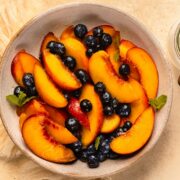
Macerating Fruit Recipe
Equipment
- 1 Clean Cutting Board
- 1 Large Non-Reactive Bowl (glass bowl or plastic bowl)
Ingredients
- 1 pound Fresh Fruit – cleaned and thoroughly dried
- 2-3 TBS Granulated Sugar (substitute: honey, agave, brown sugar)
- To Taste Flavor Enhancers – OPTIONAL (SEE NOTES)
Instructions
- Hull, Peel, Chop, or Slice Fruit (as needed): Hull strawberries, peel kiwis, and chop or slice any larger fruits, such as peaches.
- Add Fruit to Bowl: Transfer all the fruit to a large non-reactive bowl.
- Sprinkle on Sugar: Sprinkle the sugar, along with any flavor enhancers, evenly over the fruit in the bowl. Then use a wooden spoon or rubber spatula to gently stir, evenly coating the fruit in the sugar.
- Macerate: Cover the bowl with a lid or plastic wrap. Set aside and let the fruit soak in the sugar for 20-30 minutes, or until the sugar dissolves forming a syrup forms and the fruit softens. (Note: While not required, I like to stir the fruit halfway through the maceration time for even fruit-liquid-absorption.) (SEE NOTES)
- Use or Store in Fridge: Enjoy the macerated berries or soaked fruit over whipped yogurt, ice cream, pancakes, waffles, and more; or enjoy plain, straight from the bowl. Alternatively, you can transfer the covered bowl of macerated fruit to the refrigerator and store it for up to 6 hours. (Note: The longer the fruit sits, the softer and more flavorful it will become; however, after a lengthy storage, it will turn mushy!)
Notes
- Fruits: You can use this recipe to macerate most of your favorite fruits – berries, apples, mangoes, peaches, cherries, oranges, kiwis, and the list goes on. You can even use dried fruit, too! (Note: macerated dried fruits will last longer than fresh – up to 2 weeks.)
- Cleaning Fruit: Be sure to clean the fresh fruit with cool water and thoroughly pat it dry before macerating
- Flavor Enhancers: For extra flavor you can add fresh citrus (juice, zest, peel), fresh herbs, extracts, liqueurs, and vinegars. My favorite combinations:
- Strawberries: Add balsamic vinegar, fresh basil, and lemon.
- Rum Fruit Salad: Use a mixture of fruits and add dark rum, fresh mint, and a pinch of flakey sea salt.
- Brandy Mixed Berries: Use a mixture of berries and add brandy.
- Peaches: Try a mixture of brown sugar, brandy, and a splash of pure vanilla extract.
- Blood Orange Blueberries: Swap the white sugar for agave; add a little fresh lemon zest and blood orange liqueur.
- Maceration time will depend upon the type of fruit and your desired outcome. Fruits with thicker skins or harder-texture flesh will need a longer soak time to become soft and flavorful.
- Storage: Once prepared, you can store macerated fresh fruit in the fridge for up to 4 days.
Nutrition
Did you make this recipe?
Mention @nospoonnecessary on Instagram and tag it #nospoonnecessary!
©No Spoon Necessary. All images and content are under copyright protection. Please do not use any images without prior permission. If you want to reference this recipe, please link directly back to this post.

